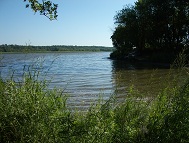Government agencies
 Many federal, state, and local government agencies have a role in managing the rich and varied water resources within the Twin Cities metro area. The following list of agencies provides a brief description of their role in water resources management. Note: This is not meant to be an exhaustive list.
Many federal, state, and local government agencies have a role in managing the rich and varied water resources within the Twin Cities metro area. The following list of agencies provides a brief description of their role in water resources management. Note: This is not meant to be an exhaustive list.
Federal
The EPA develops federal water quality criteria as well as sets and enforces national pollution control standards. The agency also provides an oversight role for state pollution control agencies.
The EPA's water home page offers a wide range of resources covering topics such as:
This agency is primarily responsible for collecting data on natural resources and the physical environment. This includes information on geological and biological resources, maps and mapping, water resources, earthquakes and other natural disasters.
In addition to their role in designing and managing construction projects for the U.S. Armed Forces, the corps has a role in designing, building and operating water resource and other civil works projects for maintaining navigable waterways and flood protection. The corps is also the main authority for permitting dredge and fill projects that affect wetlands.
State
The MPCA is responsible for statewide water quality planning, development of state water quality standards, monitoring environmental quality, and enforcing environmental regulations. They also maintain the Minnesota Stormwater Manual WIKI, a clearinghouse of information on stormwater management.
 In addition to their role of managing Minnesota's fisheries, forests and park lands, the DNR has a significant role in managing the state's water resources. The department issues permits for both the appropriations of public waters and for projects that affect public waters. The DNR also administers floodplain and shoreland management programs.
In addition to their role of managing Minnesota's fisheries, forests and park lands, the DNR has a significant role in managing the state's water resources. The department issues permits for both the appropriations of public waters and for projects that affect public waters. The DNR also administers floodplain and shoreland management programs.
The health department provides oversight for public water supply systems. It develops and enforces state drinking water standards and administers the source water protection program. The health department is also responsible for collecting information regarding the concentration of bioaccumulative chemicals in fish and publishing fish consumption advisories.
The board administers wetland and land conservation programs such as Reinvest in Minnesota (RIM) and the Conservation Reserve Program (CRP). The board provides oversight for local watershed planning agencies.
This department is primarily responsible for regulating agricultural activities that affect water resources.
Regional
Metropolitan Council
With our focus on regional issues, the Met Council offers a unique perspective on water resource management issues. We look across municipal and county lines, providing a focus on how regional issues of land use, growth patterns, and regional services affect Twin Cities water resources.
We review and comment on the watershed plans prepared by watershed management organizations, as well as water management plans prepared by local units of government as a component of their comprehensive plans.
Local
These districts are local units of government that manage and direct natural resource management programs at the local level. Districts work in both urban and rural settings, with landowners and with other units of government, to carry out a program for the conservation, use, and development of soil, water, and related resources. One crucial niche districts fill is providing soil and water conservation services to owners of private lands. Privately owned lands make up to 78% of the land surface in Minnesota. Managing these private lands, whether agriculture, forest, lakes, or urban, is key to Minnesota's quality of life.
Watershed organizations are local, special-purpose units of government that work to solve and prevent water-related problems. The boundaries of each organization follow those of a natural watershed and consist of land in which all water flows to one outlet. The districts are usually named after that watershed.
METRO AREA WATERSHED DISTRICTS
Model ordinances are created for municipal officials who want direction in regulating stormwater runoff. These models provide a valuable tool for communities developing stormwater ordinances. With careful adaptation of these models and diligent enforcement, growing cities should be able to prevent serious stormwater runoff issues.
University of Minnesota Extension uses a watershed approach that integrates the natural and social sciences (economics, evaluation, engagement, etc.) to help Minnesotans make informed decisions on
water quality. Working on issues like agriculture water quality, aquaculture, biodiversity, supply, habitat, and recreation, University of Minnesota researchers and Extension educators discover scientific answers to questions about protecting and improving water resources – helping homeowners, farmers, local decision-makers, construction managers, and landscape professionals address the challenges they face.
Additional resources
Contact
For questions or comments, please contact Judy Sventek at [email protected] or 651-602-1156.